Sponsored By
ROCK
HARDWARE
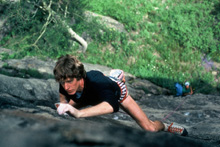
Interview: Kevin Lindorff
[ More Interviews ]
Date: 15-Dec-2003
Intro: Climbing since the early 70's Kevin has put up hundreds of new
routes in Australia and beyond and cultivated something of a reputation
for bold run-out horror shows with often under-graded technical
difficulty. Many a quick witted climber will spot his name against a route
and humbly select another instead, even with today's modern gear. While
he's freed grades around 27, Kevin has always avoided sieging sport routes
and number chasing preferring instead to seek out new routes, and
sometimes tagging them onsight and ground up such as his first ascents on
Flage Desire (27) at Frog Buttress and Delirium Termens (24) at Arapiles. His efforts have put his
name against countless routes at Mt Buffalo, particularly the North Wall
where he put up the first completely free ascent as well as the longest
hard route on the plateau. He's also been instrumental in the early development of Arapiles and the
Grampians including the now very popular Summerday Valley. These days he's living the family life in Melbourne suburbia,
working as a teacher, though still managing to lay hand to rock upon
occasion.
Above Right: Kevin Lindorff on an FA
in 11mile canyon, Colorado, 1986. All photos on this page contributed by
Kevin Lindorff.
| Notable First Ascents | ||||||||||||||||||||||||||||||||||||||||||||||||||||||||||||||||||||||||
|
Q: You've been climbing since the early 70's when you and your brother
Peter got somewhat known for "taking to the air" with regularity in an era
when "the leader must not fall" still prevailed. Can you recall your first
experiences with climbing and what got you into it?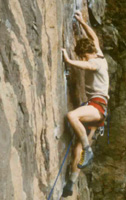
My grandfather used to caretake some caves near Murrindal, near Buchan in East Gippsland. My three elder brothers and cousin and a few of their friends got into caving. Eventually, they started to go to places like Hanging Rock to do a bit of climbing to improve their skills for their caving. However, the climbing soon became the main game. At about this time I was old enough to be allowed to go climbing with them, and then started to go with just Peter. A couple of times I conned a school friend to hitch-hike out with me from Ballarat (where I grew up) to climb some rotting columnar basalt at Lal Lal Falls. I'd snavelled an old washing line and had purchased, from a hard-wear store, a few shackles (meant to attach leashes to dog-collars) for use as surrogate karabiners. Luckily I didn't fall off anything.
As for the reputation of taking to the air, the reality was that on one weekend at Arapiles we'd tried a few routes graded about 17. That was about our limit at the time. But the climbs concerned had runners at our waists on the cruxes, so a few tiny falls hardly constituted headline news. The real issue was that Victorian climbing at the time was very clique-ridden. Some of the better established climbers of the time, but more particularly their hangers-on (including one influential magazine editor), were somewhat reluctant to accept that any outsiders might be climbing reasonably well, so any shit-throwing that might detract from our achievements was to be expected.
Q: You've done first ascents such as Delirium Tremens (24, Arapiles) and Flange Desire (27, Frog Buttress) onsight, ground up and with no prior inspection and often run-out. It's a rare leader these days who can match that ethic. The adrenaline rush and subsequent satisfaction must be rewarding? Can you recall details of either of these routes?
I did Flange Desire with British ex-pat Jeff Lamb.
I'd gone up to visit him in Brisbane and he was showing me over Frog
Buttress when we found ourselves below a blank looking corner which
somebody had obviously been trying - there were 2 shitty in-situ RPs (#1
or #2s, I can't remember) in what turned out to be very shallow
placements. Jeff didn't think the route had been done so I decided to have
a look - I guess it suited my style of climbing - not overhanging, and
some cute technical rests available from time to time. I remember getting
to a spot at about 40 or 50 feet up and clipping a very dubious RP 2 in a
shallow grove in the corner and climbing up and down the next few metres
not sure how to do what turned out to be the crux section beyond. I didn't
want to fall on the wire, so managed to downclimb all the way to the deck
(God knows how). I'd just got down when the heavens opened. It was late
afternoon and we were drenched so we beat a hasty retreat to Brisbane.
Next day we returned and I tied on and climbed the route first up.
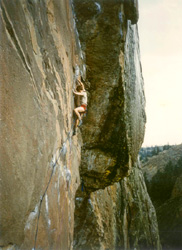
Right: Kevin Lindorff leading something (probably Guesene, 22) on Redgarden Wall, Eldorado Springs canyon, Colorado in 1986.
Delirium Tremens was vaguely similar. I had been thinking of how impressive was the upper wall of the south face of the Pharos and how great it would be to force a route straight up the middle of it. So I went up there with Tony Marian. It looked outrageous. There was an easy bit up to a little roof, where I placed a hex (which had to be extended to avoid rope-drag), then a swing up around to a stance beyond the roof. This was pre cam days, so I tried to fiddle a wire behind a flake but that was a pointless exercise. Then I climbed up a couple of metres to what is the crux and wasn't sure what to do. Because I was starting to get a little pumped, I down climbed to the stance. Then I went up again, made another move and sussed out what was ahead before down climbing a second time. I knew that if I went up again and made yet another move I mightn't be able to down climb so it would be all or nothing. So, third time up I went for it. I remember looking down at the sickening distance to the runner under the roof and Tony peering up looking powerless to help. But I judged I had enough in the tank to make the necessary moves if I didn't rush it and do anything stupid.
So yes, both scary leads but sources of great satisfaction.
Q: Would these be two of the routes of which you'd be most proud?
Yes, certainly.
Q: Apparently your first free ascent of Birdman of Alcatraz (23), which you originally graded 21, was done on-sight with a single rope, no chalk, old fashioned EB boots which didn't use sticky rubber, using homemade hexes and no cams. Can you recall anything about the ascent?
Not a lot, but I do remember that I spied from the ground what looked like a possible traverse left (a little lower than the original aided route) to a point where I might be able to move up to re-join the aided seam where it re-opened into a crack. I borrowed a single rope and a very incomplete rack of gear. The traverse was O.K but the only thing I could get in to protect the moves up was a wire which might have been O.K if pulled downward from the left - unfortunately, the rope came in from the right. So I extended the wire, clipped a big hex on it to stop it lifting out, instructed the belayer (Phil Armstrong I think) to pay out enough slack to ensure the wire didn't lift out and moved up very carefully (the crux) to the crack.
As for the grading, I vaguely remember thinking that it was easier than Wall of Horrors (also at Arapiles, but way up on the right side of Central Gully and rarely, if ever, repeated) which I'd graded 22.
Q: You mentioned you've never been into multi-day sieges of sport routes, and that you've also tended to hunt out first ascents rather than do numerous repeats of established lines. Was there ever a period when you "chased the numbers"? What part of climbing gives you the most satisfaction?
I guess I've always been fairly competitive and would have liked the kudos of climbing routes with bigger grades, but I've never really had the time, discipline or patience to do the training and the amount of climbing that is probably vital for all but the most freakishly gifted to climb hard. I've kept myself interested by doing new routes in the precious time I've been able to go climbing, rather than maybe waste a whole weekend or longer getting completely rooted on one route and maybe not getting up anything. Probably a short-sighted view. Such sieging may well have made me a lot stronger and fitter and thus enabled me to do more and harder routes more quickly.
Nonetheless, I have no major regrets. The routes
that I look back on with most satisfaction are first ascents that have
been done on sight, ground up, no prior inspection with the corresponding
degree of uncertainty and adrenalin that that entails. I've also gained
some perverse satisfaction from some easier routes that I have been scared
on but have held it together (routes such as Llafnwod, 20 at Mt Buffalo) -
I guess the sense of adventure has always been paramount to me, and maybe
that's why I have tended to focus on sniffing out first ascents rather
than doing repeats. That's not to say I don't like doing repeats - I do if
the routes are good. I like going to crags or mountains that I've never
been to before and doing the classics. It's just that it's more satisfying
to put up routes which later become classics themselves.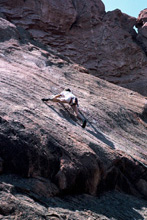
Q: Your routes have a reputation for being run-out (and under-graded). Do you think this reputation is justified? What is it about this style of climbing that appeals to you? Was the under-grading an aspect of the volume of time you'd spent on first ascents rather than repeats?
I guess I've been a conservative grader rather than a deliberate under grader. The other issue is that I think I've generally climbed better when I've been on the sharp end of something poorly protected compared to when I'm seconding and can allow myself the luxury of sloppy technique or rushing and perhaps mucking up a sequence. I guess a reasonable level of fear/anxiety, as long as it is managed and is not over-powering, can really focus the mind. And when you are really focussed you climb better and a sequence might seem a little easier than in other circumstances.
Above Right: Kevin Lindorff in The Garden of the Gods Co. 1986
Q: Given the daring nature of your ascents and penchant for new ground have you ever been involved in an epic or taken a serious fall?
I've never taken a long or serious fall. And I've never been involved in a major epic (apart from helping another party who were having one). I'm usually pretty good at sizing up whether I can do something (particularly on under vertical stuff) so when I launch out on something poorly protected its only because I'm pretty sure I can do it. If it looks beyond me and unprotected to boot I don't throw myself at it. Obviously this is not foolproof - one can misjudge or over-estimate one's ability. The most scared I've ever been was on a relatively easy route, Llafnwod (20) on Eurobin Falls at Mt Buffalo. Climbing on Eurobin is a bit different than climbing on the slabs on the rest of the Mt Buffalo plateau - the rock is water washed, not the usual rough crystalline Mt Buffalo rock medium. I hadn't climbed on Eurobin before so didn't know that. I've got reasonably strong fingers so, on normal Mt Buffalo slabs, I can usually trust to some serious crystal pulling for the odd move or two to help me out of tricky situations. On Eurobin however, your hands are often superfluous. Anyway, I spotted a line of chicken-heads heading up a blank wall to a little overlap and a slab beyond. "New route!" I thought. No runners evident so I climbed a short distance up a route to the left, placed a runner, down-climbed then launched up the chicken-heads. Before long, the runner in the route to the left was a long way down and a fair bit to the side for good measure. I moved above the overlap and onto the slab above and started to realise how slick the slab was. I realised that I was facing a 20m groundfall. I figured that if I could get up a couple of body lengths the angle would be starting to kick back and I should be O.K. So I committed myself by making a few moves up the slab. I realised that my fingers were not going to be much help at about the same time as I also realised that the rock was almost hot to the touch, my palms and fingers were sweating and my boots were creeping slowly downward on the smears. I forced myself to keep moving, pretty sure that I'd be struggling to down climb the last few moves with any semblance of control, and terrified that, if I stopped, my boots would creep off the smears and I'd come to an ugly demise. I eventually got to the stance laughingly called a belay and my brother Peter followed with ease. I certainly have no intention of ever going near that route again, except perhaps to put about 4 bolts in it.
Q: In 1977, I understand that with Glenn Tempest you free climbed (with the aid of a hanging belay) the aid route Trojan at Mt Araplies. At grade 25, this would have been the hardest route in the country (but for the hanging belay). You were obviously at the cutting edge of difficulty. Did you feel this to be the case at the time, and do you feel that you got the most out of your abilities as a climber?
On Trojan, Glenn and I each had a shot on the sharp
end, each fiddling in some gear. Then Glenn had a go with a minimal rack
and got past the previous high-point and crux, did the traverse right past
the old carrot bolts to a crack which he followed for a few moves to
easier though still steep ground where he took a semi-hanging belay. I
can't remember why he didn't belay a metre or two higher at an obvious
stance but the hard moves were certainly behind him - anyway, we were
happy with the ascent (ground up, on sight which was pretty much how we
did things back then - abseil inspection would have been cheating, besides
which it would have taken too much time frigging around and we were
probably only up for the weekend). It did seem hard but I don't think we
thought too much about how it rated compared with other routes - we just
moved on mentally to see if we could sniff out either some other aid
routes that we might be able to free, or maybe find more new routes.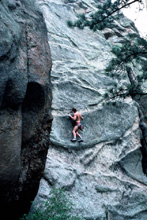
Q: I understand that when chalk for climbing was first introduced in the 70's, you initially refused to use it. Was this based on a feeling that chalk provided an unfair advantage, or on environmental grounds, or on some other reason?
Probably a bit of both. But then, as others at the time were arguing, friction boots, rope and gear all make climbing easier, so I let go of the concern that it was 'aid' pretty quickly and concentrated on using it sparingly and not leaving 'join the dots' chalk marks that might have detracted from the sense of adventure of subsequent ascensionists.
Right: Kevin Lindorff on the FA of a 5.11a (solo) in 11mile canyon Colorado 1986
Q: Whilst you had a big impact on climbing at Araplies and the Grampians, you seem to have done a lot of climbing at granite areas such as Mt Buffalo, You Yangs, Wilsons Prom etc. What is it about climbing on granite that attracts you?
I don't think that I was attracted to granite as a medium any more than, say, sandstone. It was just that I got to a stage where I'd been going to Arapiles (& the Grampians) on and off for years, I'd done most of what I wanted to do there and needed some variation to satiate my jaded climbing palate. Buffalo was attractive from a number of standpoints - there were less people there, more new routes to be done, and climbing there seemed to need more commitment and therefore offered a greater sense of adventure - a lot different from the snug and relatively non-serious atmosphere at Arapiles. But a lot of the cracks at Mt Buffalo are rough horror-shows so I soon learned that the future there was on the big sweeps of granite offered by steep slabs. The only trouble with the slabs was that they needed bolts. For someone who had been inculcated with a strong sense of not using any more 'artificial' protection (pegs and bolts) than absolutely necessary (influenced no doubt by the English ethic at the time as well as the clean climbing ethic emerging from the U.S), I guess I felt honour-bound not to put in too many bolts - that suited me anyway because it appealed to my belief that it was a good thing to keep commitment and adventure in climbing, not to mention the practical constraint that hand-drilling in granite was a huge pain in the arse.
Q: Glenn Tempest mentioned that "Along with Mike Law and Mark Moorhead, Kevin Lindorff is the most naturally gifted Australian climber that I have ever had the pleasure of climbing with" and further that "any grunt stuff (wide cracks and overhangs) and I was on the lead but if it was bold, delicate or required a certain finesse then Kevin was on the sharp end". I take it from this that run-out slabs are you speciality?
Well, maybe by default. I wasn't very strong, so I'd easily flame out on anything steep - not training and only climbing occasionally obviously didn't help. However, I was good at crimping on tiny edges and had reasonable technique on anything that was just vertical or less.
Q: Glenn also mentioned "He was also notorious for having lots of girlfriends and his late night escapades at visiting girls who worked at the Mt Buffalo Chalet is stuff of legend". Sounds like your boldness on rock transferred into other aspects too?
Most of it was just harmless adolescent fun. I'm not
sure about boldness but it was all part of seeking adventure in whatever
form I guess.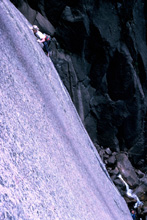
Q: There is a photo of you at a belay on a very early ascent of Hard Rain (22) on the south side of Mt Buffalo gorge that appeared in an issue of Rock Magazine (issue 34?). In the photo (from the 1970's) you appear to have a cut in half yellow drink can attached to one of the gear loops of your harness. The obvious question (which was posed by Kieran Loughran in the next issue of Rock) is what the hell is the purpose of this? Is it there as an essential part of your climbing kit, or is slamming down a can of Solo between pitches the key to mastering slabs?
I just took a can of drink along as it was a hot day and we knew we would bake on the north-facing multi-pitch route
- stupid idea as it was too sugary (and warm) to satisfy a thirst (don't believe the ads).
Right: Kevin Lindorff on the FA of The Mormon Sanction, Mt Buffalo.
Q: Of many hundreds, Overkill (**17) and Soweto (**21) at Summerday Valley are both your routes of which most newcomers to the Grampians would soon be familiar with. In fact you were so involved in the development of the area you published a small guide in "Screamer" a climbing magazine of the 80's. Can you tell us about the development? Did you have any idea at the time that Summerday would become probably the most popular of the Grampians climbing areas and those two routes I mentioned probably the most well travelled?
I'd climbed three routes in the Hollow Mountain area with Phil Armstrong ("Orange Blossom Special", "Guernica", and "Where the Woozle Wasn't") one day in September 1978, but it wasn't until I went back to the area in May 1982 with Jeff Lamb and stumbled on "Sandinista" (***,22) that the true potential of the area really dawned on me. So in 1983 I climbed a swag of new routes, mainly with my brother Peter then with Mike Wust, including some gems like Crank Start (**,23), Pass Laws(**,24), Flying Blind (*,23), Powder Monkey (***,22), Karma-lites and Armalites (**,21), Soweto (21), Overkill (17), I Surrender(*,22) , and scores of others. In those days you could drive along a sandy track (now closed) to a picnic area about a 100m from Flying Blind. It was a magic place to camp - a short wander off into the scrub to collect some of the plentiful dead wood for the campfire, parrots darting among the trees at dusk, the occasional emu wandering into the valley - and we always had it to ourselves. I couldn't figure for the life of me why most people drove to Arapiles weekend after weekend, clinging to the ritual like a security blanket, when there were heaps of unclimbed routes scattered throughout the Grampians with great camping far from the Madding Crowds. I remember writing an article for the V.C.C newsletter "Argus" at the time which reflected this very theme - and what people were missing out on. But perhaps others were more interested in socialising and surrounding themselves with other people - perhaps they felt that having hordes of others following similar pursuits at the same place somehow validated the importance of what they were doing. Nowadays, lots of them would no doubt feel compelled to use their mobile phones to keep connected - a form of separation anxiety that seems to me somehow at odds with the whole notion of adventure.
Q: Plucking another "Lindorff Classic" out of the air I'll ask about Heart Of Darkness (24) at Nightfall Pinnacles in the You Yangs which goes up the impossible looking back of the Pinnacle, basically a featureless slab with a single bolt in 20 metres. I've seen this thing. The guide gives it three stars not for popularity (I doubt anyone would have the courage to repeat it) but for the sheer audacity of the first ascent. What possessed you to all but solo this thing?
It hadn't been done - that was a red rag to a bull (I've often said that if I couldn't do new routes I'd give up climbing and do something else). Anyway, it looked O.K from below. I figured I could do it O.K. So I did.
Q: What's the story with swimming the shark infested waters of Ball's Pyramid? What was the climbing like there. Did you get up anything notable?
To be honest the climbing was very average and the
rock was friable, but it was an adventure, even just getting onto and off
the rock. We flew to Lord Howe island, took a fishing boat out to the
pyramid then had to swim to the rock - not very far as it turned out as
the sea was pretty calm. When we got to the rock we just waited for the
swell to pick us up, we'd grab on to a hold or two, the swell would
subside and we'd hope we wouldn't fall back into the water and cut
ourselves on the barnacles. No drama as it turned out. I did a route, with
Iain Sedgeman and Peter Watson, that was the first ascent of the east
face. We climbed it to where it met an obvious saddle in the sharp ridge
of the "normal" route. I remember that there were birds on every square
metre on every sloping grassed ledge. We bivouacked for a night and I
remember one indignant large bird repeatedly trying to land on one of us
during the night. I also remember centipedes between 15 and 20cm long that
would come out at night and seemed to be attracted to body-heat. Needless
to say, I was up at sparrow's fart next morning anxious to get climbing.
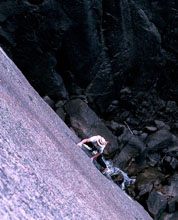
One day Keith (Noddy) Lockwood went down to a rock shelf to have a dump, misjudged the size of the swell and was washed into the water with his pants around his ankles. The current ripping past the pyramid was very strong - I remember spotting him being swept off in the general direction of French Polynesia. Fortunately, though most of our gear had been sealed in drums in preparation for our impending departure, we had a rope in an unsealed drum. We were able to feed it out as Kim Carrigan swam out to Noddy, then we were able to drag them both in. Getting off the pyramid was an adventure too - a storm had been over and the swell was much too big for the boat skipper to be enticed out from anchorage at Lord Howe island. We just had to sit out the incessant rain, sheltering under a tiny dripping overhang, and stretch our meagre rations to last many days more than we had bargained far. Eventually when the boat did show, the swell was still quite big and the skipper was adamant that we should leave our drums of gear lashed to a few bollards and he'd come and get them when conditions were calmer. We had to swim out through the swell hoping that any sharks in the area might be otherwise engaged. As for the gear, well someone in Tahiti is probably still wondering to this day where all the climbing gear came from.
Right: Kevin Lindorff on the FA of The Mormon Sanction, Mt Buffalo.
Q: Back in the late 70's you did a fair bit of bouldering at the now popular Hollow Mountain and Stapylton areas, establishing a few problems that are these days considered classics. At the time did you have any idea that the area was going to become such a draw card or that bouldering would take off as a sport of it's own?
No, not really. There were all sorts of boulder problems at Arapiles of course and a few here and there in the Grampians but bouldering was generally regarded as a useful form of training for the 'real' (roped) climbing. It was the sort of thing you could do late in the afternoon when there wasn't enough time to do a decent sized route.
Q: Apparently you put up a first ascent on a 300m wall in Zimbabwe while on a family holiday, by training a local youngster for five minutes in the art of belaying and then dragging him up. Can you elaborate on this story?
I'd been to Zim before and was drooling at the climbing potential. So, on a subsequent visit, I'd added a rope, harness, belay plate and a minimalist rack to the usual holiday gear, hoping, unreasonably, that I might meet someone who I could talk into belaying me. The lady on whose farm we were staying said that her gardener, Shepie (a 15 year old Shona boy whose English wasn't much better than my Shona) had once been led to the top of a local peak, using a rope, by an old expat pommie climber. She offered me his services as a belayer. In retrospect, I'm sure that the only use of a rope that he had made on his one and only other local peak-bagging escapade was to pull on it when scrambling up a section of steep gully. I'm also sure, now, that when he nodded eagerly to my suggestion that we climb a particular granite dome, he thought that we were in for some roped scrambling.
Anyway, to his credit, when it became apparent what
the mad Aussie really had in mind, he didn't seem too phased. I fitted him
into my harness, taught him how to belay using my belay plate, tied on and
headed up into the unknown. There were a few runners and belays on the
early pitches. All was going well (except that Shepie had managed to drop
my belay plate as he was preparing to second a pitch). Then the runners
began to dry up. I remember on the crux pitch, probably technically only
16 or 17, looking back down to the huge catenary of rope between myself
and Shepie (who had me on a waist belay), then contemplating the move
ahead (a step across a greasy water streak running down a smooth slab) and
thinking "don't fall here Kevin or you'll kill us both". Fortunately it
was much easier than I'd thought it might have been. I got up to another
(dry) water runnel and the angle began to ease. I was forced to belay
without any gear (the rope had run out) just leaning back on a foothold
the size of the edge of a cigarette pack. The inevitable happened and
Shepie fell off seconding, before I managed to give him enough assistance
to get him up without him pulling me off. From that 'belay' it was a
saunter to the top. I remember getting to the top, taking in the amazing
surrounds, listening to the African birdlife and to the baboons, and
feeling so intensely alive. Looking back I can still capture some of that
sense, though I'm also aware of how irresponsible I was to let my "new
route fever" convince me to take that young boy on that outing.
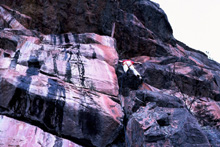
Right: Kevin Lindorff on first free ascent of Hairy Canary Redman's Bluff Grampians
Q: You've climbed overseas, including the USA, Europe and Asia. Can you tell us a little about those trips?
They fall into one of two categories: either trying to get a few days climbing in here and there whilst on family holidays, or travelling on my own and climbing for limited durations. To be honest, the best memories are about the various people I've met and the bonds I developed with them through shared adventures. For example, I fondly remember climbing in Yorkshire with some locals I'd met in the inauspicious Ilkley quarry. They 'adopted' me and we toured around for a few days in glorious weather, joking and carrying on and generally just having fun - climbing intensely when we were climbing, but not taking the whole climbing thing too seriously.
I subsequently met up with one of them, Roger, in the U.S some years later. We climber the Diamond face of Long's Peak in Colorado together - he'd always wanted to do it. We'd heard stories of other parties starting out in perfect weather only to be caught out by storms that approached from the back of the mountain and struck rapidly with great ferocity - quite a few people had died. So we were determined to start early and move fast, both of which we did. We had a ball - joking and telling stories all the way up, racing a possible storm that never came, revelling in our surroundings - the crystal clear deep blue sky and the stunning scenery.
Some of the unusual or offbeat happenings and minor epics were also memorable - an ascent of The Naked Edge (23/24, Eldorado Springs canyon), dressed in flamboyant drag with a similarly attired Liverpool lad (for a bet), mixing first ascents with searches for American Indian flint arrowheads in Penitente Canyon (Colorado), walking miles and miles along trails in the Kaisergebirge (Austria) to get to a big cliff only to find that there was a 20 minute approach from the roadhead on the other side of the mountain, getting off-route on a Messner route in the Dolomites (Italy) on very poorly-protected ground that was much harder (21/22) than it should have been then having to reverse very carefully before getting back on route and firing on to the top, wild motor-bike rides in the Indonesian rain-forests looking for obscure cliffs, and so on.
Q: You must also have met, and climbed with, an interesting array of characters over the years. Can you tell us about those that stand out as wildly successful climbers, or perhaps wildly scary or amusing?
I started climbing with my elder brother, Peter. He was very talented. He did the first ascent of a route called Aardvark in about 1971. The hard unprotected boulder-problem arÍte start has a shit landing and he soloed up it in a pair of old German klettershoe. It was the hardest climb in Victoria at the time by far (22) but never received any recognition because he graded it 17! He also used two aids in a higher section of the climb. I went back some years later to free these moves, but was scared of the start so did a direct start which bypasses the harder lower moves. This is now the 'standard' way to do the route (at 18 the section which used to be done with two aids is significantly easier than the original start). Why did he grade it 17? He figured that that's as hard as he could climb, so everything that stretched him must therefore have been 17 - can't argue with that. It's interesting that a few people who have tried to reconcile the original grading with the reality of the start have assumed that the start is now from a slightly lower spot because of the stone-work that has been done to stabilise the Organ pipes gully descent track. However, I can assure them, having checked it out closely, that that's bullshit. The start is the same. Simply put, Peter was ahead of his time.
As for others: Glenn Tempest had an infectious enthusiasm that made him a fantastic climbing partner. He was (and still is) a very positive person. In later years he used this enthusiasm like a used-car salesman to whip up hype and superlatives about whatever new crag that he happened to be keen on at the time. The inevitable result was that a new Tempest cliff tended to have a locust-like horde of acolytes visit it, accompanying Glenn of course, and dozens of new routes would be done in a few days.
Mark Moorehead was another very talented climber and a very friendly, warm human being. He had a fantastic sense of the ridiculous, a penchant for the wacky and was a fun person to be around. His humour was very different from, say, Mike Law's. With Mike you always had the sense that he was 'striving for effect', wanting so hard to shock, desperately hoping to be seen as the Oscar Wilde of the climbing scene, whereas Mark always seemed so very relaxed, so at ease with himself - as if his languid climbing style was a reflection of his easy laconic view of the world around him. Except for times when he was intensely engrossed in his climbing, my memories of him are as a person who was usually smiling, joking or laughing (never at anyone else's expense, but sometimes, in his gently self-deprecating manner, at himself) - I felt his death keenly.
Q: Most of us with jobs and families will be encouraged to hear that you've never taken up climbing full time for an extended period, instead sticking to weekend cragging. According to Glenn Tempest, the late Mark Morehead (one of Australia's best climbers), once commented that if you did ever go fulltime "we may as well all go home". Have you ever been tempted by the climbing bum lifestyle? At the peak of your climbing life how did you juggle work/family vs climbing?
I suppose my upbringing was fairly conservative so I always figured I'd get a job then try to fit climbing around the edges. Trying to juggle family vs climbing has been difficult and been the source of significant tension between my wife (now my ex-wife - that probably tells you something) and I - maybe the result was that I didn't do justice to either my family or my climbing. Maybe that's a harsh view - I don't pretend to completely understand even with the advantage of hindsight.
Quite a few to choose from:
Q: Okay, generic question time, what's your favourite crag in Victoria, and all time favourite climb?
Favourite crag? I'm not sure I have one. I guess it
depends on my mood. It's like food - you might have a favourite dish but
that doesn't mean you want to eat it all the time. And if you do eat one
too frequently, you can easily become sick of it and develop a new
favourite. Arapiles is amazing but I've been going there forever so get
bored with it easily (though its great after I haven't been there for a
while), Mt Stapylton has a broad range of classics (maybe I can get
someone to drag me up a few things on Taipan Wall one day soon), Rosea has
some fantastic climbs on it (and is the source of some fond memories for
me though I haven't been there for years) and Mt Buffalo has some great
stuff. Favorite Victorian climb? Hard to pick one. I have a preference for
multi pitch routes, so it's hard to go past something like Hard Rain (22,
Mt Buffalo) where every pitch is good, every pitch is different, and the
rock is sublime.
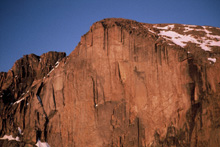
Q: Do you have a climbing hero/heroine?
Not really. Its easy enough to be a specialist so I guess I'm more impressed with those people who climb to a high level right across the board from bouldering, sports routes, trad routes and big alpine routes. Lyn Hill was an example of someone who could move seamlessly (no pun intended) from indoor competition to freeing multi-pitch extravaganzas in Yosemite. An impressive woman.
Right: Longs Peak, 14,000ft., Colorado
Q: So what does your future hold in terms of climbing? What's next on the agenda?
I'm not sure. I'd like to go to places that I've not been to before and also to places that I've been to only once or twice before but have really enjoyed. I must admit I'm attracted to the thought of big multi-pitch routes with people I get on well with. There's a route on the South face of the Marmolada (in the Dolomites) called 'Weg durch den Fisch" (The Way through the Fish) which is very long, hard, sparsely protected, and on excellent rock all the way. Trouble is, I'd probably need someone else to drag my sorry arse up it. But it's good to have dreams. Without them, you might as well curl up and die.
Further Reading: ![]()
Rock Magazine - A one page write up
in the "Rogues' Gallery" Autumn 1998.
Home | Guide | Gallery | Tech Tips | Articles | Reviews | Dictionary | Forum | Links | About | Search
Chockstone Photography | Landscape Photography Australia | Australian Landscape Photography
Please read the full disclaimer before using any information contained on these pages.
All text, images and video on this site are copyright. Unauthorised use is strictly prohibited.
